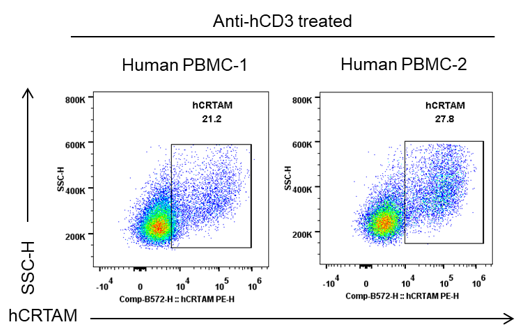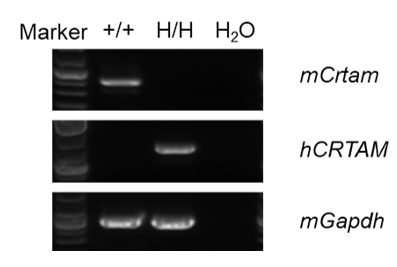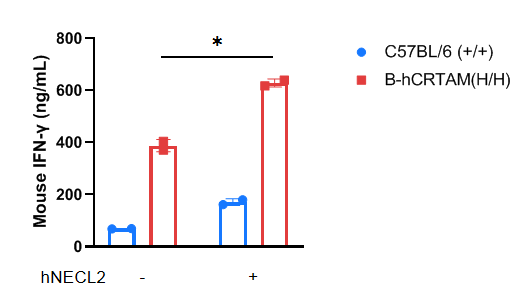


C57BL/6-Crtamtm1(CRTAM)Bcgen/Bcgen • 112532
| Product name | B-hCRTAM mice |
|---|---|
| Catalog number | 112532 |
| Strain name | C57BL/6-Crtamtm1(CRTAM)Bcgen/Bcgen |
| Strain background | C57BL/6 |
| Aliases | CRTAM; CD355 |
Gene targeting strategy for B-hCRTAM mice.
The exons 1~8 of mouse Crtam gene that encode the extracellular domain was replaced by human CRTAM exons 1~8 in B-hCRTAM mice.

Strain specific CRTAM expression analysis in homozygous B-hCRTAM mice by flow cytometry. CD8+ T cells were sorted from the splenocytes in wild-type C57BL/6 mice (+/+) and homozygous B-hCRTAM mice (H/H) and stimulated with anti-mCD3e in vitro (0.5 μg/mL, stimulation for 72 hours) and anti-mCD28 in vitro (1 μg/mL, stimulation for 72 hours). Protein expression was analyzed with anti-mouse CRTAM antibody (Biolegend, 142007) and anti-human CRTAM antibody (Biolegend, 339106) by flow cytometry. Mouse CRTAM was exclusively detectable in wild-type mice. Human CRTAM was exclusively detectable in homozygous B-hCRTAM mice but not in wild-type mice.

Human CRTAM expression analysis in human T cells by flow cytometry. Human T cells were stimulated with anti-hCD3 in vitro (20 μg/mL, stimulation for 48 hours), and analyzed by flow cytometry with species-specific anti-CRTAM antibody (Biolegend, 339106). Human CRTAM was exclusively detectable in human T cells by anti-human CRTAM antibody. Human hPB CD3+ Cells purchased from Milestone Biotechn

Strain specific analysis of CRTAM mRNA expression in wild-type C57BL/6 mice and B-hCRTAM mice by RT-PCR. Spleen RNA were isolated from wildtype C57BL/6 mice (+/+) and homozygous B-hCRTAM mice (H/H), and then cDNA libraries were synthesized by reverse transcription, followed by PCR with mouse or human CRTAM primers. Mouse Crtam mRNA were detectable only in wild-type C57BL/6 mice. Human CRTAM mRNA was detectable only in homozygous B-hCRTAM mice but not in wild-type mice.

Induction of mouse IFN-γ was induced with human NECL2 in wild-type C57BL/6 mice and homozygous B-hCRTAM mice. CD8+ T cells were isolated and induced with anti-mCD3e (0.25 μg/mL)(BioXcell, BE0001-1), anti-mCD28 (0.5 μg/mL) (BioXcell, BE0015-1) with or without hNECL2 (5 μg/mL) (ACROB, CA1-H5225) for 72h. Concentration of mouse IFN-γ secreted from CD8+ T cells was assayed with anti-mouse IFN-γ antibody (Biolegend, 430804) by ELISA. Mouse IFN-γ was successfully induced with human hENCL2 in homozygous B-hCRTAM mice. These results indicate that humanized CRTAM can recognize human NECL2 ligands to activate CD8+ T in homozygous B-hCRTAM mice. Values are expressed as mean ± SEM. Significance was determined by Multiple t tests. *P < 0.05, **P < 0.01, ***P < 0.001.